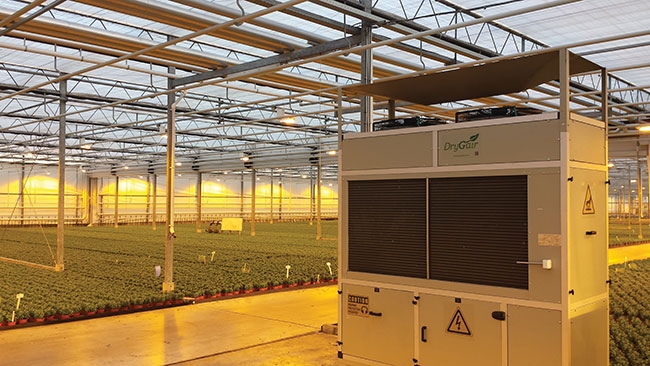
Features
Environmental Control
Structures & Equipment
Dehumidification may land funding for Ontario farmers
With the window for GCII applications closing, it may be time to consider dehumidification.
September 4, 2018 By Rom Meir
 Photo credit: DryGair
Photo credit: DryGairIn late September, the AAC (Agricultural Adaptation Council) will be closing its application submissions for the “Greenhouse Competitiveness and Innovation Initiative” (GCII).
This is a $19 million fund, aimed towards Ontario greenhouse growers to increase competitiveness, through innovation and investment, to help invigorate Canada’s agriculture sector. The initiative aims to help greenhouses increase their efficiency, quality and output.
With dehumidification technologies on the rise, and with GCII submissions coming to a close, this is the time to get acquainted with the opportunities they may provide.
Why dehumidification
Plants are fussy creatures. Every grower knows this, and parameters such as temperature and light are commonly regulated to meet a plant’s needs. But crops have preferred levels of relative humidity as well. More importantly, pests, bacteria and fungi have their optimal humidity levels too.
We’ve mapped out the major reasons why dehumidification can be an asset to any operation:
Energy
Traditionally, humidity has been dealt with using ventilation. Though this may seem like an easy, inexpensive fix, it’s actually quite the opposite. Greenhouse air temperature is constantly being adjusted to meet the crops’ specific temperature levels, using a whole lot of energy to do so, especially in colder climates. When ventilating, this precious energy (and money) is literally being thrown out the window. With a dehumidification system in place, you could close everything up, conserve your heat and deal with humidity levels in-house. Dehumidifying correctly can save around 50 per cent on average, compared to the energy consumption of ventilated greenhouses.
Crop loss and pesticides
Humidity-related diseases, such as gray mold, powdery mildew and downy mildew lead the way when it comes to crop loss. Chances are you’ve encountered one, if not all of these. These are all fungi that require high levels of relative humidity to become threats. In fact, by dehumidifying effectively, crop losses could be cut by as much as 25 per cent. Cutting crop loss is one side of this coin, the other being a reduction of pesticide and fungicide usage.
Resource efficiency leads to quality and quantity
Closing up a greenhouse and throwing in a proper dehumidifier has some added benefits. The most obvious of these is water savings. Not all, but certain refrigerant-based dehumidifiers can remove 45 liters (12 gallons) of water an hour (at 18 degrees Celsius, 80% RH). This distilled water, that would otherwise be wasted, can be saved and re-used by the grower for any purpose, within local regulations.
Optimal humidity for plants coupled with less than favourable conditions for diseases allows for denser crop placement. The outcome of which is a larger quantity of product in the same amount of space. Combine this with higher quality and faster growth and you have a serious argument for the introduction of a dehumidifier to your operation.
Introducing a new piece of equipment to the growing space is also a great opportunity to improve on additional factors which aren’t as apparent. But no technology is the same. When choosing between dehumidifying systems, look for one that creates air circulation to help maintain uniformity throughout the greenhouse. This helps in avoiding “pockets” of microclimates which are suboptimal to the plant.
Now is the time
As we’re nearing the end of the GCII submission window, it’s time to start thinking about adopting dehumidification, a rising technology in the greenhouse sector and a very viable way to achieve all three of the fund’s goals.
Rom Meir is the content writer for DryGair, a company specializing in dehumidification technology for greenhouses.
Print this page